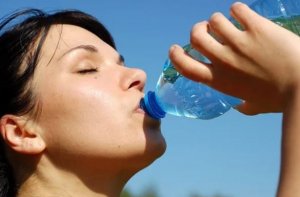Flatulence: Why it Happens and What to do About It

There are several hypotheses behind the causes of flatulence. But, the only thing we’re sure of is that it manifests as acute pain located under the ribs, in the upper part of the abdomen, next to the diaphragm. Another empirical fact is that it occurs while doing some sort of strenuous physical effort, such as running abruptly or exercising without warming-up.
Why does it happen, what to do about it and how to prevent it? Is there a sport that makes athletes more prone to flatulence? Is it something related to what we eat or drink before exercising? Are some people more susceptible than others? We’ll explain the answers to all of these questions in the sections below.
Possible causes of flatulence
Until recently, it was assumed that accumulated gases produced flatulence. This explanation has since been ruled out by other more consistent hypotheses. However, there isn’t enough evidence to give those of us who’ve experienced this pain an answer.
Clinically, flatulence is known as “exercise-related transient abdominal pain” (ETAP) and is directly related to physical activity. What makes it particularly associated with sports is that it appears during exercising and disappears a few seconds after stopping.
There are at least three possible explanations to account for why flatulence occurs. The first and most common is that it’s related to food or liquids ingested before doing sports. However, not all foods or beverages produce flatulence.
Muscular rigidity is the second possible cause as to why some athletes could experience flatulence more often than others. Specifically, it’s possible that the muscles that keep the spine stable are too rigid or hypertonic. This rigidity could cause throbbing pain under the diaphragm.

The third hypothesis entails respiratory issues to explain the existence of flatulence. A lack of oxygen in the muscle, due to a lack of coordination between the diaphragm and respiratory movement can lead to acute pain.
The influence on other organs
In line with the last hypothesis regarding the lack of oxygen, another possible explanation is that the ligaments of the diaphragm extend to nearby organs, such as the liver. This situation is due, as in the third hypothesis, to a lack of coordination when breathing. This tension is higher if you ingest “heavy” foods before exercising.
In fact, a multifunctional phenomenon explanation for flatulence is currently the most accepted of the answers; which means that it can appear due to different reasons or in indistinct ways.
However, a follow-up can be performed on the sports in which flatulence appears more frequently. For example, it’s said that swimming can expose a higher number of people to one of these intense pains. Running comes second, along with horse riding, aerobics, basketball, and cycling, in that order.
Are some people more prone to flatulence?
Although there are no determining causes, some people appear to be more prone to it. Someone who has a kyphotic posture, for example, will have his or her spine tilted forward which will cause stiffness in the entire back; they’ll have affections, especially in the cervical muscles.
On the other hand, flatulence is much more frequent in children and young adults than in people over 30 years old. However, gender has no influence, since it appears equally in men and women.
How to avoid flatulence
Making a habit of avoiding foods that cause stomach or intestinal bloating is a good start to prevent flatulence. It’s also essential to train your lungs and diaphragm, hold your breath for as long as you can at a constant pace.
Other resources for you to consider and that allow you to carry out sports in a responsible manner include:
- Go running, swimming or do aerobics with your stomach as empty as possible.
- Drink water in small sips while training.

- Choose an ideal shoe for each type of physical activity.
- Visit a physiotherapist if it’s kyphosis.
- Warm your muscles up before training.
What should I do if I feel pain?
First, don’t stop moving abruptly. It’s best to press down on the area where you feel pain and very slowly flex your torso; when the pain starts to fade, you have to perform a lateral movement, stretching the side where there was flatulence. Afterward, you can resume your usual exercises.
There are several hypotheses behind the causes of flatulence. But, the only thing we’re sure of is that it manifests as acute pain located under the ribs, in the upper part of the abdomen, next to the diaphragm. Another empirical fact is that it occurs while doing some sort of strenuous physical effort, such as running abruptly or exercising without warming-up.
Why does it happen, what to do about it and how to prevent it? Is there a sport that makes athletes more prone to flatulence? Is it something related to what we eat or drink before exercising? Are some people more susceptible than others? We’ll explain the answers to all of these questions in the sections below.
Possible causes of flatulence
Until recently, it was assumed that accumulated gases produced flatulence. This explanation has since been ruled out by other more consistent hypotheses. However, there isn’t enough evidence to give those of us who’ve experienced this pain an answer.
Clinically, flatulence is known as “exercise-related transient abdominal pain” (ETAP) and is directly related to physical activity. What makes it particularly associated with sports is that it appears during exercising and disappears a few seconds after stopping.
There are at least three possible explanations to account for why flatulence occurs. The first and most common is that it’s related to food or liquids ingested before doing sports. However, not all foods or beverages produce flatulence.
Muscular rigidity is the second possible cause as to why some athletes could experience flatulence more often than others. Specifically, it’s possible that the muscles that keep the spine stable are too rigid or hypertonic. This rigidity could cause throbbing pain under the diaphragm.

The third hypothesis entails respiratory issues to explain the existence of flatulence. A lack of oxygen in the muscle, due to a lack of coordination between the diaphragm and respiratory movement can lead to acute pain.
The influence on other organs
In line with the last hypothesis regarding the lack of oxygen, another possible explanation is that the ligaments of the diaphragm extend to nearby organs, such as the liver. This situation is due, as in the third hypothesis, to a lack of coordination when breathing. This tension is higher if you ingest “heavy” foods before exercising.
In fact, a multifunctional phenomenon explanation for flatulence is currently the most accepted of the answers; which means that it can appear due to different reasons or in indistinct ways.
However, a follow-up can be performed on the sports in which flatulence appears more frequently. For example, it’s said that swimming can expose a higher number of people to one of these intense pains. Running comes second, along with horse riding, aerobics, basketball, and cycling, in that order.
Are some people more prone to flatulence?
Although there are no determining causes, some people appear to be more prone to it. Someone who has a kyphotic posture, for example, will have his or her spine tilted forward which will cause stiffness in the entire back; they’ll have affections, especially in the cervical muscles.
On the other hand, flatulence is much more frequent in children and young adults than in people over 30 years old. However, gender has no influence, since it appears equally in men and women.
How to avoid flatulence
Making a habit of avoiding foods that cause stomach or intestinal bloating is a good start to prevent flatulence. It’s also essential to train your lungs and diaphragm, hold your breath for as long as you can at a constant pace.
Other resources for you to consider and that allow you to carry out sports in a responsible manner include:
- Go running, swimming or do aerobics with your stomach as empty as possible.
- Drink water in small sips while training.

- Choose an ideal shoe for each type of physical activity.
- Visit a physiotherapist if it’s kyphosis.
- Warm your muscles up before training.
What should I do if I feel pain?
First, don’t stop moving abruptly. It’s best to press down on the area where you feel pain and very slowly flex your torso; when the pain starts to fade, you have to perform a lateral movement, stretching the side where there was flatulence. Afterward, you can resume your usual exercises.
All cited sources were thoroughly reviewed by our team to ensure their quality, reliability, currency, and validity. The bibliography of this article was considered reliable and of academic or scientific accuracy.
- Emilio Juan García. Por qué tengo flato. Instituo Aragonés de la Rodilla. Extraído de: http://www.traumazaragoza.com/traumazaragoza.com/Documentacion_files/%C2%BFPor%20que%CC%81%20tengo%20flato%3F.pdf
- Pérez Ayán, C. Revista Andaluza de Medicina del Deporte. 2010. Dolor abdominal transitorio vinculado al ejercicio. Extraído de: https://www.redalyc.org/pdf/3233/323327663005.pdf
This text is provided for informational purposes only and does not replace consultation with a professional. If in doubt, consult your specialist.








